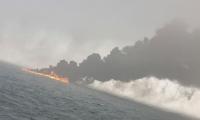The strategic shift from geo-politics to geo-economics is a welcome initiative. In a world where the relative importance of a nation is determined primarily by its economic strength, the focus on geo-economics embodies the right response to national and international challenges.
Geography has always been considered an element of national power. Napoleon once said: “The foreign policy of a country is determined by its geography.” While this may be an exaggeration; there’s an element of truth in it. Location tends to make a state a land or sea power.
An obvious example is England, whose superiority over other European countries largely consisted in it being a greater sea power. Not only that, England’s being an island and thus cut off from continental Europe by the English Channel contributed to its leadership in constitutional government and industry, as it remained largely immune from dynastic struggles of continental countries. Location may also make a state a battleground – as Lebanon is at present – or a buffer zone, as Afghanistan remained for the greater part of its modern history.
The MidEast/Gulf region has remained at the crossroads of the world not only for cultural and religious reasons but because of its geographic and strategic location and its oil wealth – which is a function of its location – as well, situated as it’s at the junction of three continents (Asia, Europe, and Africa). That’s the reason keeping the area off-limits to the former USSR remained a cornerstone of Washington’s foreign policy during the cold war era.
Some countries because of their strategic location are in a better position to attract trade and investment than others. Pakistan is one such country. It lies on the cusp of three of the most important regions in the world: East, South, Central Asia and the Gulf area. To the north of Pakistan is China, the world’s second largest economy and the largest trading nation. To the east, lies India, currently the largest economy in the world. To the north-west of Pakistan is land-locked Afghanistan and beyond that land-locked and energy rich Central Asia. Pakistan provides the shortest land route to Afghanistan for its overseas trade. To the south-west is Iran, which accounts for among the world’s largest gas and oil reserves. The Arabian Sea to the south, which forms northwestern part of the Indian Ocean, constitutes one of the world’s busiest trading routes.
Had Pakistan been able to cash on its strategic location, it would have become a trade, transport and investment hub. On the contrary, the strategic location turned out to be Pakistan’s Achilles Heel and reduced it to a hotbed of militancy, partly because national priorities were misplaced and partly because world or regional powers used our territory for waging their proxy wars.
Foreigners by and large saw Pakistan as an instable country with a high political risk, where their lives and assets wouldn’t be safe. Hence, despite entering into different regional and bilateral preferential trading arrangements, Pakistan couldn’t become part of global value chains (GVCs), which account for nearly a half of the global trade, despite its locational advantage and having arguably the most liberal trade and investment regime in the region.
As a result, the country received meagre FDI inflows over the years and had to rely mainly on foreign loans to finance the trade and current account deficits, thus accumulating a massive debt. Success in courting the IMF to give us loan is touted as a stupendous achievement of the government. Likewise, debt rescheduling and issuing fresh credit is an important talking point when our leaders meet their richer foreign counterparts. The perpetual need to borrow more to work off the existing debt as well as finance the persisting current account deficit reduced both strategic and economic choices available to the government.
Pakistan’s geo-strategic environment remains uncertain, thus further constraining its economic choices. The lingering Kashmir issue together with BJP-led New Delhi’s hegemonic posture will continue to impede normalisation of economic relations with India. As a result, the economic potential of South Asian Association for Regional Cooperation (Saarc) is likely to remain underutilised, thus keeping South Asia as arguably the least economically integrated regions across the globe.
If Afghanistan continues to remain instable, the prospects for trade with Central Asian Republics will remain dim. The volatile situation in the Mideast and Washington’s continuing sanctions on Tehran will continue to cast its shadow on revival of full-scale trade between Pakistan and Iran.
All the same, substantial opportunities are offered by the international economic environment. The most evident of such opportunities are offered by the Belt and Road Initiative (BRI), the mega infrastructure and development programme sponsored by the Chinese government.
Announced in 2013, the BRI is geared towards connecting Asia with Africa and Europe by land, maritime and digital networks. The hard and soft connectivity would spur trade and economic integration and accelerate economic growth and development. More than 130 countries have signed up for the BRI.
Partly because of its strategic location and partly because of its outstanding relations with China, Pakistan has an important role to play in BRI implementation. The China-Pakistan Economic Corridor (CPEC), which was unveiled in 2015, is one of the six corridors under the BRI. CPEC links the Chinese province of Xinjiang with Pakistan and substantially reduces time and cost of western China’s trade with the Gulf region and around it, African and European countries.
Because of CPEC, China has become the largest source of FDI into Pakistan, mainly through energy and infrastructure related projects. What we need now is Chinese investment in manufacturing and agriculture. Because of increase in wages in China, many labour-intensive industries are relocating offshore. Should we put our house in order, Pakistan can serve as a credible option for the Chinese enterprises wishing to relocate to low wage countries.
CPEC is open to participation by third countries and Chinese investment may encourage other capital abundant countries to step up investment in Pakistan and thus will enable the country to realise its investment potential as well as become part of some of the GVCs in such sectors as information and communication technology, textiles and automobiles. The recently held meeting of the heads of government of Shanghai Cooperation Organisation (SCO), the China-led initiative for security and economic cooperation, in Islamabad will shore up Pakistan’s profile as a business-friendly country.
At the same time, there are some challenges that need to be addressed. Because of space constraints, only three may be mentioned here. Ensuring security of foreign investors and workers and safety of foreign assets remains the biggest challenge for Pakistan. The recent targeting of Chinese nationals conveys a negative signal, to say the least, to foreign investors, especially those from China.
Macroeconomic stability is also of paramount importance. If, for example, the rupee keeps going down, the foreign investors, who earn in the rupee and then convert it to the currency of their country of origin, will have their returns diminished. Likewise, high inflation will rack up the cost of doing business and offset Pakistan’s advantage of being a country that’s is cheaper to produce in.
The third important challenge will be ensuring efficient and effective economic governance. Governance in Pakistan continues to remain hostage to the principle of ‘administrative efficiency,’ which is a relic of the colonial era.
Economic management requires specialised knowledge and skills. However, it continues to be an exclusive domain of the officials from the Pakistan Administrative Service (PAS), whose core competence consists in administering districts and divisions primarily with a view to collecting revenue and maintaining law and order. Dealing with the 21st century intricate economic issues through a 19th century administrative apparatus simply isn’t on.
The writer is an Islamabad-based columnist. He tweets/posts @hussainhzaidi and can be reached at: hussainhzaidi@gmail.com
An AI-powered robot waves at the onlookers at a tech show. — AFP/FileNine years ago, between March 9 and 15, 2016,...
Their children are also more likely to survive childhood, be healthy and attend school
Report notes that country has 800,000 heroin users and most commonly abused drugs are cannabis, heroin
Europe has vowed to stand with humiliated president in solidarity
On January 29 this year, mid-air collision, first major US aviation accident since 2009, challenged this optimism
Until these ideological foundations are dismantled, cycle of extremism will continue







